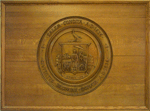Salem Public Library: Difference between revisions
mNo edit summary |
mNo edit summary |
||
| Line 5: | Line 5: | ||
The mansion was immediately refurbished to man a main hall, public reading room, trustees' room, reference room and bookstacks. | The mansion was immediately refurbished to man a main hall, public reading room, trustees' room, reference room and bookstacks. | ||
In 1911, Boston architect Clarence H. Blackall appended a four-story fireproof | On the lawn of the library is found one of the very few Victorian fountains that survived the scrap drives of World War II. | ||
In 1911, Boston architect Clarence H. Blackall appended a four-story fireproof book stack ell, a one-story reference room wing, and a corresponding office. Another extensive renovation was executed during the years 1979-1990. | |||
Revision as of 10:38, 12 February 2010
The Salem Public Library was originally built as a home for Captain John Bertram and his family. In 1855, the Bertram family moved from their smaller house at 24 Winter Street and took up residence in their new High Style Italianate brick and brownstone mansion at 370 Essex Street. The household consisted of Captain Bertram; his third wife, Mary Ann Ropes, 44; Joseph, 20 an adopted son of his second wife; three daughters (by his first and second wives) Jenny, 18 (later to become the mother of Caroline O. Emmerton, founder of the House of Seven Gables); Clara, 16; Annie, 10 and an adopted daughter, Grace, 7. (Another daughter, Ellen Augusta, had died in 1848, aged 8).
Honored and beloved by the whole community, Bertram died on March 22, 1882, aged 86 years, at his home. He was buried in his mausoleum at Harmony Grove Cemetery. His widow purchased and moved into the Assembly House on Federal Street. In a letter dated December 1, 1887, his widow and daughters offered the Mansion on Essex Street to the City of Salem for use as a Public Library. The offer was accepted and the Salem Public Library opened its doors on July 8, 1889.
The mansion was immediately refurbished to man a main hall, public reading room, trustees' room, reference room and bookstacks.
On the lawn of the library is found one of the very few Victorian fountains that survived the scrap drives of World War II.
In 1911, Boston architect Clarence H. Blackall appended a four-story fireproof book stack ell, a one-story reference room wing, and a corresponding office. Another extensive renovation was executed during the years 1979-1990.
See Also
- Salem Public Library Salem Public Library (History of the library building)
- John Bertram Salem Website
- The Legacies of Captain John Bertram Video recording by Erik Smith with SATV, 2007
- Architecture in Salem by Bryant F. Tolles, p.161-2
